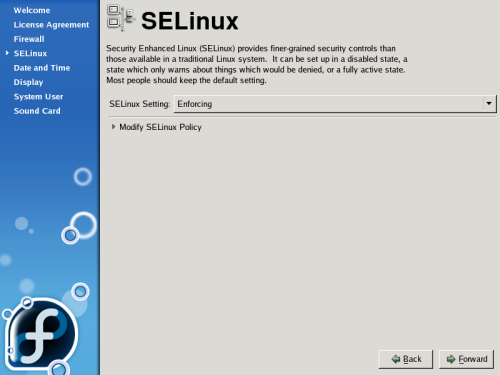The SELinux (Security Enhanced Linux) framework is part of Fedora Core. SELinux limits the actions of both users and programs by enforcing security policies throughout the operating system. Without SELinux, software bugs or configuration changes may render a system more vulnerable. The restrictions imposed by SELinux policies provide extra security against unauthorized access.
Inflexible SELinux policies might inhibit many normal activities on a Fedora system. For this reason, Fedora Core uses targeted policies, which only affect specific network services. These services cannot perform actions that are not part of their normal functions. The targeted policies reduce or eliminate any inconvenience SELinux might cause users. Set the SELinux mode to one of the following:
- Enforcing
Select this mode to use the targeted SELinux policy on your Fedora system. This is the default mode for Fedora installations.
- Permissive
In this mode, the system is configured with SELinux, but a breach of security policies only causes an error message to appear. No activities are actually prohibited when SELinux is installed in this mode. You may change the SELinux mode to Enforcing at any time after booting.
- Disabled
If you choose this mode for SELinux, Fedora does not configure the access control system at all. To make SELinux active later, select System → Administration → Security Level and Firewall.
To adjust SELinux, choose Modify SELinux Policy. To exempt a key service from SELinux restrictions, select the service from the list, and choose the Disable SELinux protection option. The SELinux Service Protection item on the list includes options to disable SELinux restrictions on additional services.
![[Tip]](./stylesheet-images/tip.png) | Changing the SELinux policy |
|---|---|
SELinux is unique in that it cannot be bypassed, even by the system administrators. To change the behavior of SELinux after installation, choose System → Administration → Security Level and Firewall. |
For more information about SELinux, refer to the SELinux FAQ at http://fedora.redhat.com/docs/selinux-faq/.
